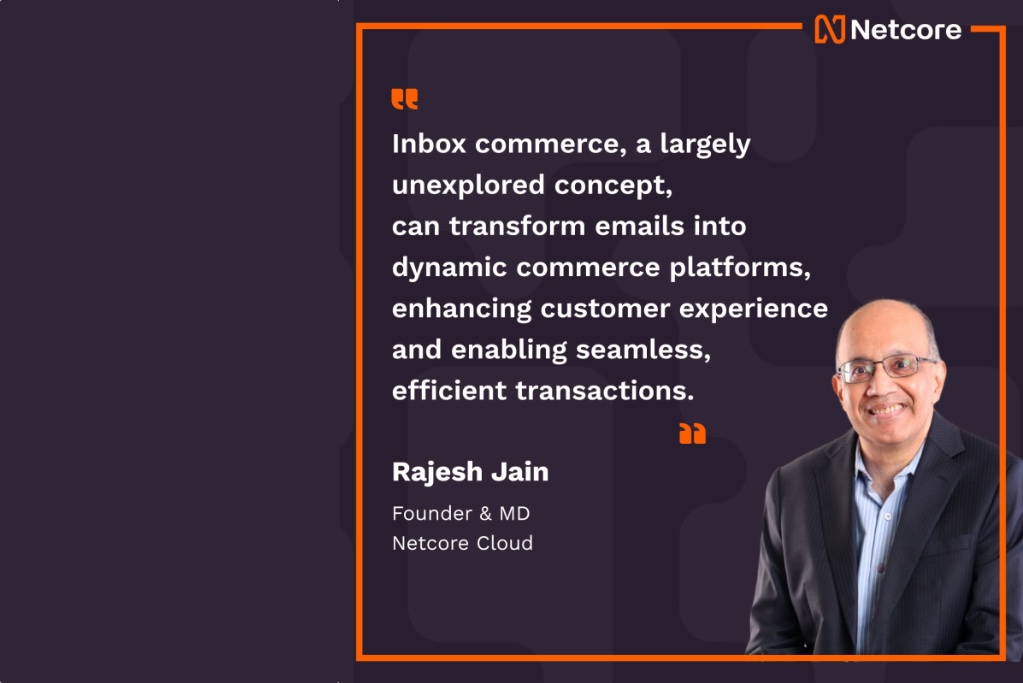Amidst the fervor surrounding the transformative potential of Generative AI in recent months, particularly in its application as copilot or autopilot, we mustn’t overlook a significant trend that has eluded our attention.
Our email inbox as the commerce enabler
In this era of transformative technology, our email inboxes are also undergoing a remarkable evolution. They are evolving into dynamic platforms that foster two-way communication and empower seamless commerce. This shift from a mere communications tool to a catalyst for conversation and commerce holds profound significance for sellers.
By eliminating the friction that traditionally compelled buyers to navigate to external websites and apps for transactions, this shift promises unparalleled opportunities for streamlined engagement and enhanced customer experience.
Think of this as a shift from “far” commerce to “near” commerce, where the entire spectrum of search, browsing, and purchasing seamlessly integrates into our inboxes. As these transactions become effortlessly accessible, brands can cut down expenditures on wasteful customer acquisition and unlock higher profitability.
By embracing this evolution, businesses can forge deeper connections with customers, optimizing the efficiency of sales processes. This convergence of convenience and profitability is poised to reshape the future of commerce, fostering sustainable growth and enabling brands to thrive in an increasingly interconnected marketplace.
Pioneering the Era of Inbox Commerce
It is fascinating to observe that a search for “inbox commerce” or “inbox ecommerce” yields an unexpectedly modest number of results, with a combined total of less than 15,000. Remarkably, the correlation between the concepts of inbox and ecommerce remains largely unexplored.
This untapped synergy presents an exciting opportunity to delve into unchartered territory and unlock the potential of integrating these two domains. By doing so, we can pioneer new frontiers of innovation and uncover novel ways of enhancing customer experience, redefining traditional commerce, and revolutionizing the way we engage with our inboxes.
To cross-verify, I turned to ChatGPT to give an overview of Inbox commerce, and we happen to be on the same page:
Inbox commerce refers to the practice of conducting business transactions, promoting products or services, and engaging with customers within messaging platforms or email inboxes. The idea is to streamline the customer experience and make it more convenient by allowing users to interact with businesses and make purchases directly within the messaging apps or emails, without leaving the platform.
The coming rise of inbox commerce is being driven by a number of changes in our inboxes:
- AMP in Email eliminates redirects and unlocks the potential to craft captivating mini-applications within the emails.
- SMS is becoming two-way. (certain regulatory limitations in India persist, impeding the full realization of this potential)
- Over the past year, WhatsApp has opened its platform for brand conversations. As WhatsApp Pay proliferates, buying inside the app will become simpler.
- RCS (think of it as an SMS upgrade) can also bring commerce closer to consumers.
- AI-enriched product catalogs can improve relevance and power recommendations across channels.
- Chatbots can simplify the creation of search and browse workflows.
- While not an “inbox,” ChatGPT has shown how a search bar can become a window to almost anything.
All these innovations will change the “where” of commerce. Traditionally, brands focused on driving their buyers to their websites and apps to complete transactions. This has been a point of friction since unidirectional push messages (like emails and SMSes) had to persuade consumers to click and change the context of the brand properties.
The evolving interactivity in push channels opens up new possibilities for conducting commerce directly within the inbox. Netcore’s AMP in Email has already demonstrated remarkable results for early adopters, with a staggering increase of 5-15 times (500-1500%) in user actions performed within emails.
While the initial focus has been on enhancing engagement, the natural progression is to enable seamless shopping experiences. By empowering customers to make purchases without leaving the email environment, brands can tap into the immense potential of inbox commerce and drive greater conversions and revenue.
Once the payment layer gets streamlined and embedded inside the messages, frictionless commerce will be here – right inside the inbox where all of us spend so much time each day. This will herald one of the biggest leaps in ecommerce in years, if not the past couple of decades.
Why should brands embrace inbox commerce?
Inbox commerce holds significant importance for marketers and brands, presenting a distinctive and convenient avenue to engage customers, boost sales, and foster enduring relationships.
- Convenience: Inbox commerce allows customers to interact with businesses, browse products, and make purchases without leaving their messaging apps or email inboxes. This convenience can lead to higher conversion rates.
- Personalization: Messaging platforms and emails enable businesses to deliver personalized content based on user preferences, behavior, and past interactions leading to improved engagement and higher sales.
- Enhanced customer support: Providing real-time customer support through chatbots or live agents, resulting in faster resolution of issues and improved customer satisfaction.
- Better open and engagement rates: Compared to traditional marketing channels, messaging apps, and emails often have higher open and engagement rates. This means that marketing messages delivered via inbox commerce are more likely to be seen and acted upon by customers.
- Increased customer retention: By offering a seamless and convenient shopping experience through inbox commerce, businesses can foster long-term relationships with their customers and encourage repeat purchases.
- Integration with other marketing channels: Inbox commerce can be integrated with other marketing channels such as social media, websites, and apps to create a cohesive and consistent customer journey, reinforcing brand messaging and driving sales.
- Data-driven insights: Businesses can gather valuable data on customer behavior and preferences through interactions on messaging platforms and emails, which can inform future marketing strategies and help optimize campaigns for better results.
Inbox commerce is important for marketers and brands because it allows them to create a more convenient, personalized, and engaging shopping experience for customers, ultimately leading to higher conversion rates, increased customer loyalty, and better overall business performance.
The “WOW” effect of Inbox commerce
To demonstrate the capabilities of this groundbreaking technology, I embarked on a journey to the United States, bringing Netcore’s inbox commerce solution to the forefront. It was an exhilarating experience marked by two prominent trade shows: eTail West in Palm Springs and Shoptalk in Las Vegas.
As we unveiled the potential of turning the Gmail inbox into a fully functional shopping channel, marketers were captivated by the possibilities. Witnessing a seamless experience of browsing a product catalog, adding items to the cart, selecting a shipping address, and making a payment – all within the confines of their email inbox – left them in awe.
It was a definitive “wow” moment that sparked a realization: this could very well be the future of their business. The profound impact of this innovation resonated deeply, igniting a sense of excitement and anticipation among marketers who recognized the tremendous potential for growth and customer engagement.
What we were unveiling was nothing short of extraordinary – the power to accomplish everything within the confines of an email. It was a groundbreaking concept that had never been witnessed or experienced before. It was evident that we had stumbled upon something truly significant.
As my colleague eloquently expanded the idea from “All-in-Email” to “inbox commerce,” it became clear that this innovation had the potential to revolutionize the world of ecommerce. It promised a remarkable win-win scenario for both buyers and sellers, offering unparalleled convenience and efficiency.
The beginning of a new-age tech category?
Consider the promise of conversational search in ecommerce. Today, the search ends with a list of products shown. Now imagine being able to continue to refine the product list with the search. The basic idea is the same as inbox commerce: reduce the steps, clicks, and friction to enable a transaction.
As Lenin said, “There are decades where nothing happens; and there are weeks where decades happen.”
This is what we are now living through. Even as the macro environment screams slowdown and recession, the pace of innovation across sectors is amazing. Entrepreneurs are working to solve problems – as they always do, but the speed at which new solutions can be brought to the market is accelerating.
Inbox commerce is one such innovation that promises to transform the way we transact with brands.
MARKETING Magazine is not responsible for the content of external sites.










